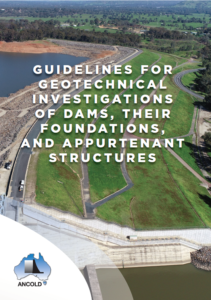- Home
- Resources & Information
-
-
Resources & Information
-
Member Resources
- ICOLD Website Login
- ICOLD Circulars
-
-
- News & Events
- Membership
-
-
ANCOLD Membership
-
-
-
- About Us
 Dam safety requires a thorough understanding of the characteristics of the foundation and the materials that will be used, or have been used, for construction of a dam. These guidelines aim to improve practice to benefit dam owners through more effective and targeted investigations required to answer key questions about dams and their foundations.
Dam safety requires a thorough understanding of the characteristics of the foundation and the materials that will be used, or have been used, for construction of a dam. These guidelines aim to improve practice to benefit dam owners through more effective and targeted investigations required to answer key questions about dams and their foundations.
Guidance is provided to owners, those preparing briefs for site investigations and for consultants carrying out the work. The Guidelines have been prepared to cover all types of water storage and tailings dams, both new and existing.
Common issues and objectives are described along with the steps required to undertake the investigations and appropriate methods.
These Guidelines are the culmination of extensive voluntary work by the Chairman, Emeritus Professor Robin Fell, and his Working Group. It is a significant development for dam engineering in Australia and will be a valuable resource.
$195.00

ANCOLD is an incorporated voluntary association of organisations and individual professionals with an interest in dams in Australia.